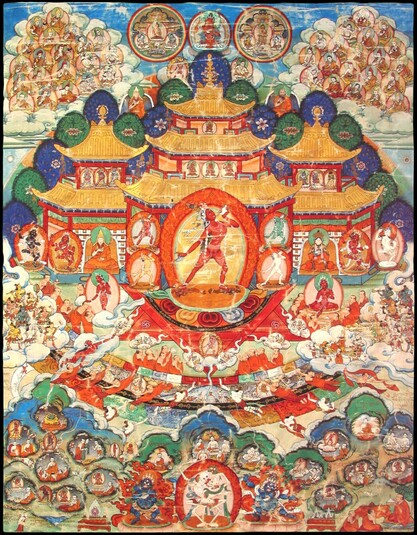
Item: Vajrayogini (Buddhist Deity) - (Naropa Tradition)
| Origin Location | Mongolia |
|---|---|
| Date Range | 1900 - 1959 |
| Lineages | Sakya and Gelug |
| Material | Ground Mineral Pigment on Cotton |
| Collection | Publication: Wisdom Publications, Calender |
| Catalogue # | collection of Schoettle |
Classification: Deity
Appearance: Semi-Peaceful
Gender: Female
Vajrayogini and the Khechara Pureland (Tibetan: dor je nal jor ma ka cho ma). At the lower right and left of the composition are narrative vignettes depicting each of the Eleven Yogas of Vajrayogini according to the system of Naropa.
Sanskrit: Vajrayogini Tibetan: Dor je nal jor ma
Tibetan: Dor je nal jor ma
At the top center is Vira Vajradharama, red in colour, the primordial Buddha of the Wisdom Tantras. Lineage teachers are arranged in a descending order on the right and left sides. Vajrayogini is depicted in a palace along with additional mandala deities. On the left side, wearing a yellow pandita hat, is the 8th Jetsun Dampa of Mongolia. Seated on the right side is the consort of Jetsun Dampa.
At the bottom center is Shri Shmashana Adhipati, the special protector for the Vajrayogini cycle of practices. On the left side is Panjarnata Mahakala. On the right side is Chaturmukha Mahakala.
The narrative vignettes on the right and left sides of the lower composition depict each of the eleven special forms of yoga associated with the Vajrayogini as taught by the Indian mahasiddha Naropa.
"Vajrayogini, on a multi-coloured lotus and sun seat, with the right foot extended pressing down on the breasts of red Kalaratri, left pressing on the backward bent head of black Bhairava. With a body red in colour, brilliant, like the fire at an aeon's end, one face, two hands, three eyes gazing at the pure [realm] of Khechara. The right hand holds a vajra marked curved knife extended downward, left, a blood filled skullcup held above with the face looking upward and drinking. On the left shoulder is a vajra marked katvanga with a damaru, bell and three hanging pendants. Black hair in strands extends to the waist, youthful and with large breasts of desire, in a mood generating bliss. Having a crown of five dry human skulls and a necklace of fifty; naked, adorned with five mudras; Vairochana as a crown; standing in the middle of a blazing fire of pristine awareness." (Khyabdag Nesar Ngawang Kunga Legpa'i Jungne, 1704-1761).
Guru Lineage: Vajradhara, Vajrayogini, Mahasiddha Naropa, Pamtingpa, Sherab Tseg, Mal Lotsawa, Sachen Kunga Nyingpo, Sonam Tsemo, Dragpa Gyaltsen, Sakya Pandita, Chogyal Pagpa, etc.
Vajrayogini, the 'Khechari of Naropa' (Tibetan: dor je nal jor ma, na ro kha cho ma). Belonging to the Chakrasamvara collection of Tantras and one of the five principal tantric practices of the Sakya School. Bibliographic reference: Laghusamvara Nama.
Vajrayogini, is a representation of complete buddhahood in female form. Classified as Wisdom or 'Mother' Anuttarayoga Tantra the practices originate with the Chakrasamvara Cycle of Tantras. Although found in a variety of forms, she is common to all schools of Tibetan Buddhism. In this particular form she belongs to a special teaching passed down from the lineage of the Indian mahasiddha Naropa through to the Sakya School. This form also became popular within the Gelugpa Tradition.
(Inscriptions beneath each narrative vignette).
Jeff Watt 10-2002
Wisdom Calendar 2002 - November (full catalog list)
Buddhist Deity: Vajrayogini Art History
Tradition: Gelug Deity Paintings
Tradition: Sakya Deity Paintings
Buddhist Deity: Vajrayogini Main Page
Buddhist Deity: Deities (Female)
Subject: Transferance (Powa)
Buddhist Deity: Vajrayogini Iconography/Index of Names
Buddhist Deity: Vajrayogini, Khechara Pureland Masterworks
Buddhist Deity: Vajrayogini, Khechara (Naropa Tradition)
Buddhist Deity: Vajrayogini, Khechara Pureland
Buddhist Deity: Vajrayogini Subject Outline
Buddhist Deity: Vajrayogini, Khechara (Naropa Tradition) Painting Masterworks
Buddhist Deity: Vajrayogini (Masterworks)
Buddhist Deity: Vajrayogini Videos
